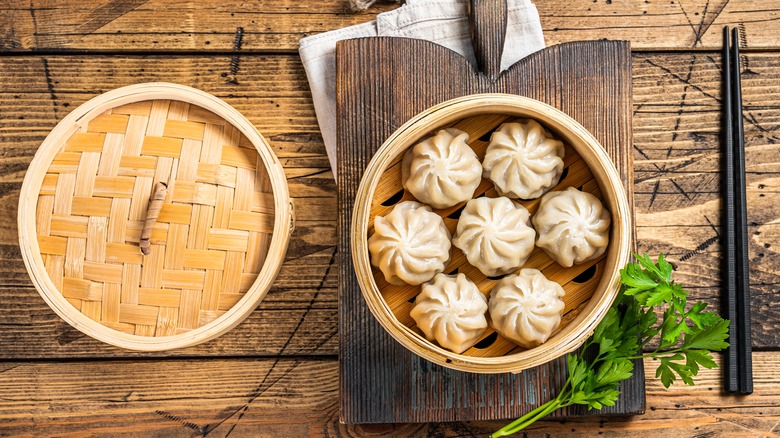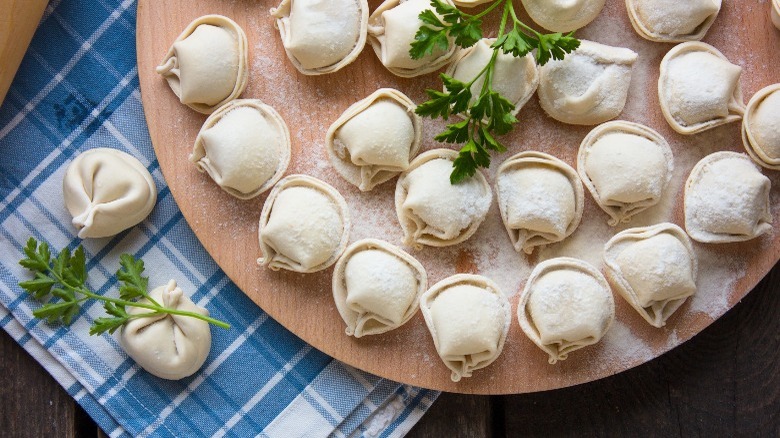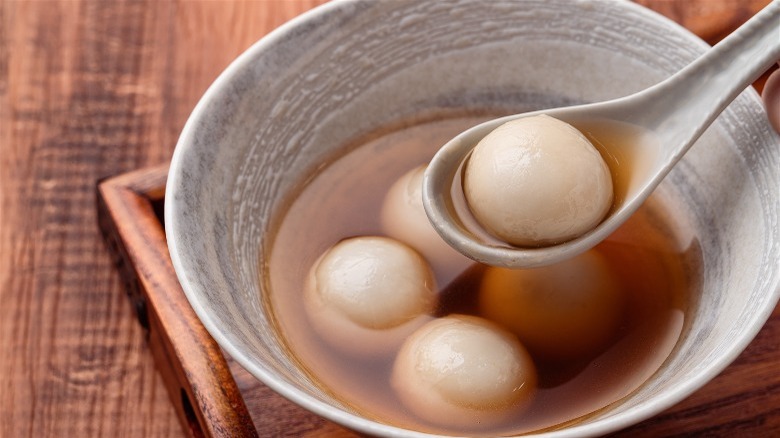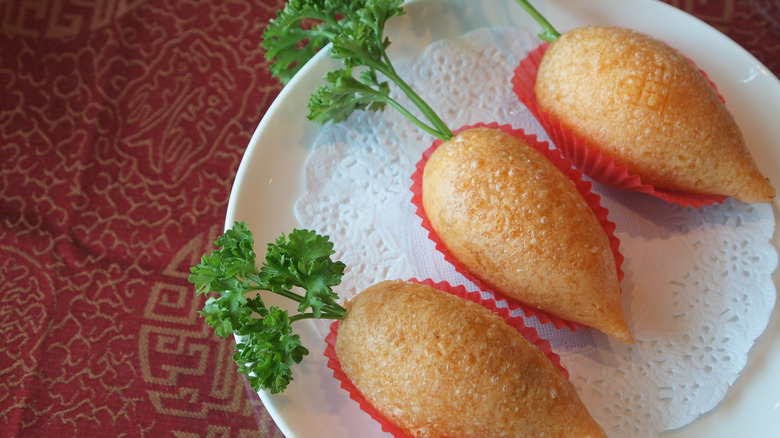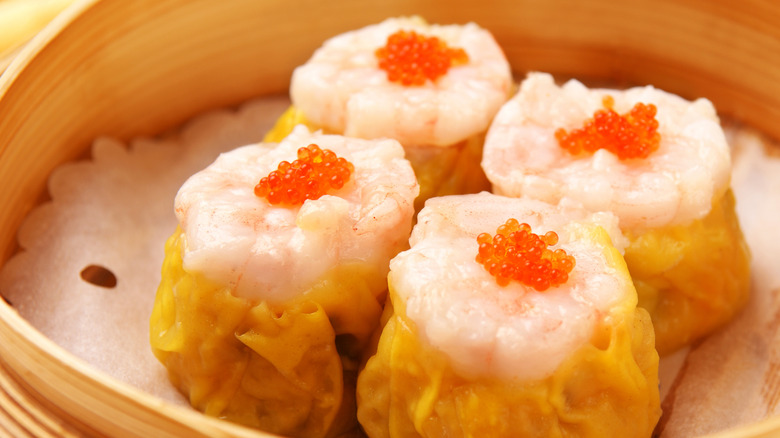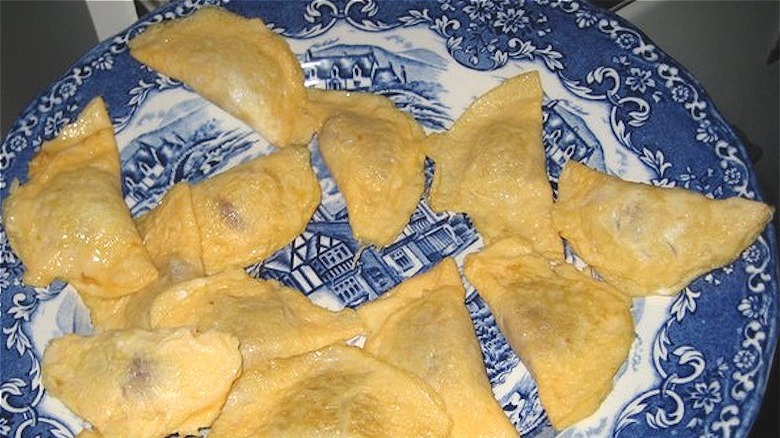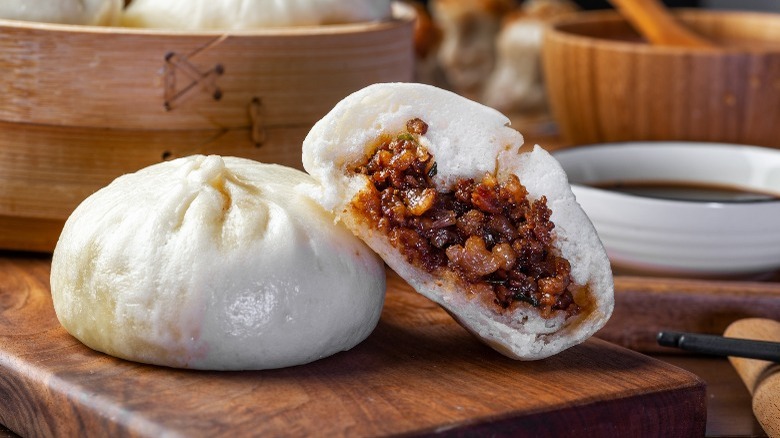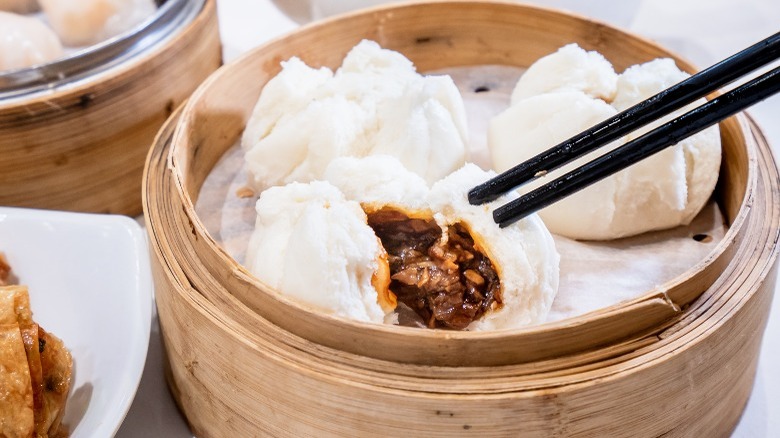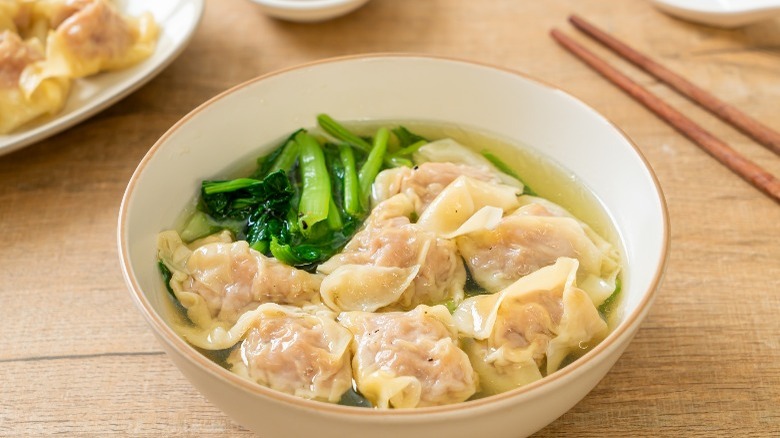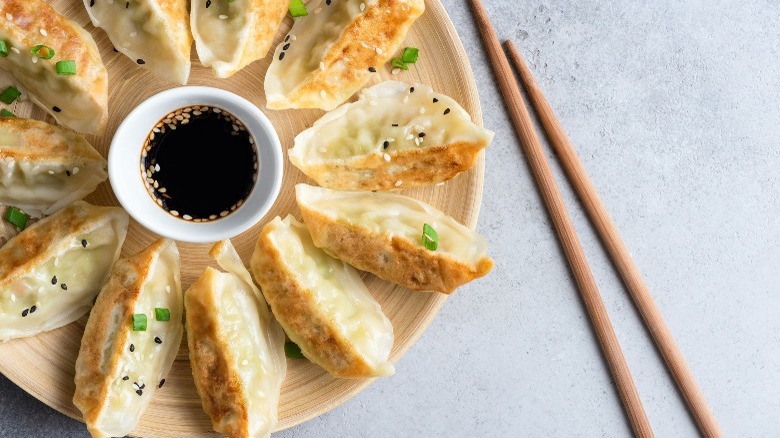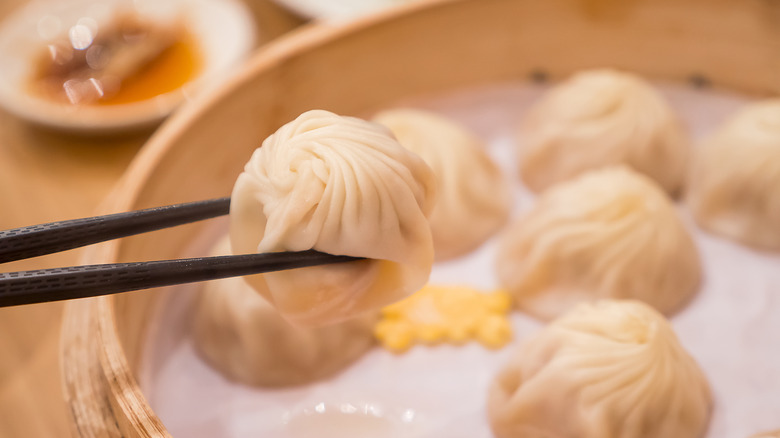10 Types Of Chinese Dumplings That Will Have You Craving Asian Cuisine
Dumplings could very well be considered one of the most popular foods in the world. Nearly every culture has its take on the dumpling, from the Empanadas of South America to Khinkali of Georgia. They're a beloved food that satisfies bellies around the globe, but perhaps the cuisine most associated with dumplings is Chinese food, where the array of dumplings is seemingly endless. Dumplings have deep roots in China's culinary history and exist in many different versions for all types of occasions.
Historians believe that Chinese medicine practitioner Zhang Zhongjing invented dumplings to help people stay warm during cold months and when packed with healing herbs, they served as a delicious way to also ward off frostbite, according to Chef One Foods.
In northern China, you can find soft dumplings made of a wheat-based dough, while in Southern China, the wrappings are often made out of rice. They come in an array of shapes and sizes, with meat or vegetarian filling, packing an explosion of flavors within a small sheet of dough, explains China Highlights. Traditional fillings include cabbage, mushroom, shrimp, fish, or beef. And who would forget about the famous minced pork filling, which is popular in many styles of dumplings? Today, dumplings are enjoyed for nearly any reason at any time of the day, but traditionally they were made in bulk for the family to celebrate Chinese New Year and symbolized good financial fortune.
If you're intrigued, we've rounded up 10 types of Chinese dumplings to know, so keep reading to find out a bit more about this fascinating food.
Shuijao
Shuǐjiǎo are a traditional type of dumpling popular throughout northern China. The name Shuǐjiǎo can be translated to boiled or water dumplings, says Miss Panda Chinese, indicating that they are cooked in hot water. They are served on their own but there may also be a dip to enhance the flavor. Although they originated from and continue to be popular in northern China, they've made their way all across the country, becoming a family favorite.
It's more of an anything-goes attitude when it comes to what to stuff these with so there is no traditional filling for these dumplings. It can be anything, from red and white meats to various types of vegetables. If purple cabbage is your thing, you can find some Shuǐjiǎo stuffed with that as well.
Shuǐjiǎo are usually made in bulk, shaped like a crescent, and served during big family gatherings. They're popular during the Lunar New Year, explains Taste Atlas. It's a family event where everyone gathers together and forms a production line with each member taking up a responsibility — rolling dough, stuffing, and folding. If you're fortunate enough to eat them on New Year's keep your eye (and teeth) alert for a coin. The Los Angeles Times explains that some chefs hide a coin inside a dumpling, and the finder will be wrapped in fortune for the rest of the year.
Tang Yuan
If you think of dumplings you might imagine a savory filling wrapped in a wheat-based dough. But Chinese cuisine offers other varieties, such as Tang Yuan. These dumplings are on the sweeter side of the spectrum and are amazingly delicious, explains Red House Spice. The dough is made of rice flour and water which is kneaded for a very long time, activating the gluten in the flour and making these dumplings rather chewy. Fillings can vary but the traditional one is a mixture of sugar, lard, and grounded nuts like sesame or peanuts.
The filling is more on the runny side giving it a great counterpart to the more dense exterior. One great thing about Tang Yuan dumplings is that you can substitute the ingredients. So, if you don't like lard, you can also use coconut oil for the filling, for example. This delicious dumpling is served in a bowl filled with a bit of the same water the dumplings are being cooked in; this ensures the filling stays runny and mixes well with the dumpling itself when eating. These little balls of joy are also eaten around Chinese New Year's first full moon, explains BBC, and they symbolize good luck! You can find this sweet dumpling in both the northern and southern parts of the country.
Ham Sui Gok
If you don't have much of a sweet tooth but are on the hunt for a savory option that has the chewy, fluffy texture of many soft dumplings, these next ones may pique your interest. Ham Sui Gok are fried dumplings made out of rice flour, explains Wok and Kim. These dumplings are deep fried in oil in a large pan which gives them a crispy outer crust, while the inside remains chewy and gives Ham Sui Gok an intriguing texture. They're a popular dim sum option.
The traditional filling is succulent pork belly (and sometimes shrimp and sausage) cooked with a variety of Cantonese spices such as ginger, pepper, and pickled radish, to offer an explosion of flavors in your mouth from the first bite to the last. They may not be the healthiest option if you're trying to skip the deep fried foods, but they are without a doubt one of the best. You can eat these dumplings on their own with a dipping sauce or serve them as a great side dish to your family feast.
Siu Mai
Dumplings don't always need to have a closed, bulbous shape. Siu Mai are a great example of this. Siu Mai, originally from the Inner Mongolia region in the very northern part of China, is a dumpling that made its way far across the borders, according to SCMP. One can find versions of this dumpling in Japanese and Vietnamese cuisine, for example, but the dumpling is popular in Hong Kong and Cantonese cuisine.
This open-faced dumpling is made out of wheat flour and is usually filled with meat like pork or crab and steamed in bamboo baskets. Originally the filling was mutton with ginger and scallions but over the years and with different iterations of Siu Mai you can find it with any variation of fillings.
They're a food that can be found in street food markets as well as high-end dim sum restaurants. The name Siu Mai translates to "served while being hot" which indeed describes the way these dumplings are supposed to be eaten. The steaming gives Siu Mai a very light-feeling dough that almost has a pasta-like texture and does not overpower the filling.
Dan Jiao
Another great dumpling to showcase the food's undeniable range are Dan Jiao. The wrapper is actually not based on flour, but it's made of egg!
These dumplings are fluffy and much lighter than their dough-wrapped counterparts. The filling is usually minced pork but you can find many varieties of these in restaurants. Although they look like tiny omelets, they're rather time-consuming to make because you need to cook one dumpling at a time. The Woks of Life even explains that it's often the teenager of the family who makes these because they're old enough to be careful but young enough not to protest the labor-intensive task!
But it's all worth it in the end. Although Dan Jiao are delicious on their own, traditionally you add them to soups so they don't dry out and can remain warm. Like many types of dumplings, they are a favorite on New Year's but the word of their deliciousness spread so far that they're enjoyed all year long in all parts of the globe. Dan Jiao are a must-try for anyone who considers themselves a dumpling aficionado and wants to try something new.
Baozi
Next up are Baozi, also called Bao Buns. These dumplings are wheat flour-based and usually steamed in bamboo baskets, giving them their signature light and fluffy texture. Originating from northern parts of China during the third century, Bao Buns are based on a bread-like dumpling with no filling called Mantou, explains Chung Ying Restaurant. The fillings vary from different types of meat to variations of vegetables, so there are pretty much no limitations.
Because they are steamed under high temperatures the filling becomes a little soupy. And because of this, the bun itself stays rather moist and keeps its fluffy texture. This brings a whole new level to the dumpling in flavor and texture. Imagine spicy chicken stew presented in a pillow made out of dough. This is Baozi. They could be classified as the everyday dumpling in Chinese cuisine and also they're very popular in the street food scene, according to Red House Spice. Baozi come in different sizes so you could have it as a starter to your meal or for lunch with a salad.
Char Siu Bao
Another great option when it comes to steamed dumplings, and a very close relative to Bao Buns is Char Siu Bao. These delicious dumplings are made from four ingredients: flour, water, sugar, and pork, according to Hashtag Legend. This simple recipe hits the spot so amazingly accurate that it was never forgotten and made its way across the globe. Char Siu Bao originates from the traditional steamed bun Mantou, which was invented in the third century in China.
The steamed buns were especially convenient for travelers but did not have much flavor to them and so the idea of filling these buns developed. You can consider Char Siu Bao as one of the oldest street food and now comes in many varieties with many different fillings. These dumplings can be found in markets and high-class restaurants where the recipe continues to evolve. But the original one is filled with sweet and spicy pork, and you will never be disappointed.
Wonton
Wontons are ubiquitous in American Chinese food. In soups, steamed with a dipping sauce, or even fried with some grilled vegetables, these dumplings are a mainstay all over the world. They are also called the Chinese ravioli, according to Taste Atlas, and have origins in northern China. The dumpling wrapping is wheat flour based, which is traditional for dumplings from northern China where wheat was grown and harvested for a very long time. But what sets these apart is that the dough contains egg, as well, which makes the Wontons very light and silky.
Wontons are usually filled with pork but you can find many different fillings today. The texture also allows for various cooking methods, all of which provide amazing results. Wontons are another ancient style of dumpling, dating back to the Han Dynasty and its dough-making process paved the way for other dough-based food like bread, noodles, and other types of dumplings.
Today, Wontons are a popular dish enjoyed in Chinese-American cuisine throughout the United States. You've probably even tried it as a soup, with several wontons floating in a bowl of clear broth.
Jiaozi
When someone refers to Chinese dumplings, Jiaozi is often what comes to mind. These delicious gems have any kind of filling and are wrapped in a silky wheat flour-based dough and boiled in water. They are also often pan-fried afterward, giving the outer shell a crunchy bite which elevates the dumpling to new levels. Jiaozi is one of the very first iterations of wheat flour-based dumplings, but its origins are unfortunately not quite clear.
One story explains that they were invented by doctor Zhang Zhongjing for medical use around the year 200 AD, explains Easy Tour China. Another story claims it was invented during the Tang dynasty by an emperor's chef which was from 618 to 908 AD. Whichever story is true, Jiaozi's impact is impossible to ignore. The traditional filling was minced pork mixed with vegetables such as cabbage or mushrooms. Today any filling imaginable is used for Jiaozi, like crab, fish, spinach, or chives. There is definitely a Jiaozi for every palate!
Xiao long bao
We can probably all agree that dumplings are incredibly tasty, in pretty much any iteration. But what about those times when you want a little bit of everything? Maybe a vegetable, meat, and a piping hot bowl of soup? What if you could have it all in one spoon? Well, that's where Xiao Long Bao come in. The name comes from the baskets these dumplings are being steamed in, explains The Real Review. And the steaming process is the only way to make Xiao Long Bao what they are: Soup dumplings.
The filling is minced pork mixed with vegetables made into a ball. The soup is made separately, using the skin and bones of the animal. The fat and the bone marrow help to create a gelatinous texture that binds the ingredients once the soup cools. The liquid will transform into a gel-like consistency which is cut into small cubes and put into the wheat flour dough wrapper alongside the meatball. When the dumplings are steamed, the gel turns back into a liquid soup, and the meat cooks in liquid soup so all the flavors integrate into one another deliciously, creating such a level of depth and flavor that's hard to find in any other dumpling. Xiao Long Bao are special and definitely a must-try for any dumpling lover.
